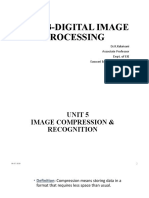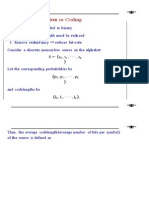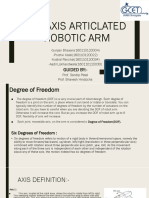Source Coding Ompression
Uploaded by
최규범Source Coding Ompression
Uploaded by
최규범Source Coding-
Compression
Most Topics from Digital Communications-
Simon Haykin
Chapter 9
9.1~9.4
Fundamental Limits on Performance
Given an information source, and a noisy channel
1) Limit on the minimum number of bits
per symbol
2) Limit on the maximum rate for reliable
communication
Shannons theorems
Information Theory
Let the source alphabet,
with the prob. of occurrence
Assume the discrete memory-less source (DMS)
What is the measure of information?
0, 1 -1
{ , .. , }
K
S s s s =
-1
0
0,1, .. , - 1 ( ) , 1
K
k k k
k
k K P s s p and p
=
= = = =
Uncertainty, Information, and Entropy
(cont)
Interrelations between info., uncertainty or surprise
No surprise no information
If A is a surprise and B is another surprise,
then what is the total info. of simultaneous A and B
The amount of info may be related to the inverse of
the prob. of occurrence.
1
( . )
Pr .
Info
ob
~
.( ) .( ) .( ) Info A B Info A Info B +
1
( ) log( )
k
k
I S
p
=
Property of Information
1)
2)
3)
4)
* Custom is to use logarithm of base 2
k k
(s ) 0 for p 1 I = =
k
( ) 0 for 0 p 1
k
I s > s s
k i
( ) ( ) for p p
k i
I s I s > <
indep. statist. s and s if ), ( ) ( ) (
i k i k i k
s I s I s s I + =
Entropy (DMS)
Def. : measure of average information
contents per source symbol
The mean value of over S,
The property of H
1) H(S)=0, iff for some k, and all other
No Uncertainty
2) H(S)=
Maximum Uncertainty
) (
k
s I
K-1 K-1
2
k 0 k 0
1
( ) E[ ( )] ( ) log ( )
k k k k
k
H S I s p I s p
p
= =
= = =
2
0 ( ) log , ( # ) H S K where K is radix of symbols s s =
1 =
k
p 0 ' = s p
i
2
1
log ,
k
K iff p for all k
K
=
Extension of DMS (Entropy)
Consider blocks of symbols rather them individual symbols
Coding efficiency can increase if higher order DMS are used
H(S
n
) means having K
n
disinct symbols where K is the # of
distinct symbols in the alphabet
Thus H(S
n
) = n H(S)
Second order extension means H(S
2
)
Consider a source alphabet S having 3 symbols i.e. {s0, s1, s2}
Thus S
2
will have 9 symbols i.e. {s0s0, s0s1, s0s2, s1s1, ,s2s2}
Average Length
For a code C with associated probabilities p(c) the average
length is defined as
We say that a prefix code C is optimal if for all prefix
codes C, l
a
(C)
s l
a
(C)
l C p c l c
a
c C
( ) ( ) ( ) =
e
Relationship to Entropy
Theorem (lower bound): For any probability
distribution p(S) with associated uniquely decodable
code C,
Theorem (upper bound): For any probability
distribution p(S) with associated optimal prefix code
C,
H S l C
a
( ) ( ) s
l C H S
a
( ) ( ) s +1
Coding Efficiency
Coding Efficiency
n = Lmin/La
where La is the average code-word length
From Shannons Theorem
La >= H(S)
Thus Lmin = H(S)
Thus
n = H(S)/La
Kraft McMillan Inequality
Theorem (Kraft-McMillan): For any uniquely decodable code
C,
Also, for any set of lengths L such that
there is a prefix code C such that
NOTE: Kraft McMillan Inequality does not tell us
whether the code is prefix-free or not
2 1
s
l c
c C
( )
2 1
s
l
l L
l c l i L
i i
( ) ( ,...,| |) = =1
Uniquely Decodable Codes
A variable length code assigns a bit string (codeword)
of variable length to every message value
e.g. a = 1, b = 01, c = 101, d = 011
What if you get the sequence of bits
1011 ?
Is it aba, ca, or, ad?
A uniquely decodable code is a variable length code in
which bit strings can always be uniquely decomposed
into its codewords.
Prefix Codes
A prefix code is a variable length code in which no
codeword is a prefix of another word
e.g a = 0, b = 110, c = 111, d = 10
Can be viewed as a binary tree with message values at the
leaves and 0 or 1s on the edges.
a
b c
d
0
0
0 1
1
1
Some Prefix Codes for Integers
n Binary Unary Split
1 ..001 0 1|
2 ..010 10 10|0
3 ..011 110 10|1
4 ..100 1110 110|00
5 ..101 11110 110|01
6 ..110 111110 110|10
Many other fixed prefix codes:
Golomb, phased-binary, subexponential, ...
Data compression implies sending or storing a
smaller number of bits. Although many methods are
used for this purpose, in general these methods can
be divided into two broad categories: lossless and
lossy methods.
Data compression methods
Run Length Coding
Introduction What is RLE?
Compression technique
Represents data using value and run length
Run length defined as number of consecutive equal values
e.g
1110011111 1 3 0 2 1 5
RLE
Values Run Lengths
Introduction
Compression effectiveness depends on input
Must have consecutive runs of values in order to maximize
compression
Best case: all values same
Can represent any length using two values
Worst case: no repeating values
Compressed data twice the length of original!!
Should only be used in situations where we know for sure have
repeating values
Run-length encoding example
Run-length encoding for two symbols
Encoder Results
Input: 4,5,5,2,7,3,6,9,9,10,10,10,10,10,10,0,0
Output: 4,1,5,2,2,1,7,1,3,1,6,1,9,2,10,6,0,2,-1,-1,-1,-1,-1,-1,-1,-1,-1,-1
Best Case:
Input: 0,0,0,0,0,0,0,0,0,0,0,0,0,0,0,0
Output: 0,16,-1,-1,-1,-1,-1,-1,-1,-1,-1,-1,-1,-1,-1,-1,-1,-1,-1,-1
Worst Case:
Input: 0,1,2,3,4,5,6,7,8,9,10,11,12,13,14,15
Output: 0,1,1,1,2,1,3,1,4,1,5,1,6,1,7,1,8,1,9,1,10,1,11,1,12,1,13,1,14,1,15,1
Valid Output
Output Ends Here
Huffman Coding
Huffman Codes
Invented by Huffman as a class assignment in 1950.
Used in many, if not most compression algorithms such
as gzip, bzip, jpeg (as option), fax compression,
Properties:
Generates optimal prefix codes
Cheap to generate codes
Cheap to encode and decode
l
a
=H if probabilities are powers of 2
Huffman Codes
Huffman Algorithm
Start with a forest of trees each consisting of a single
vertex corresponding to a message s and with weight
p(s)
Repeat:
Select two trees with minimum weight roots p
1
and p
2
Join into single tree by adding root with weight p
1
+ p
2
Example
p(a) = .1, p(b) = .2, p(c ) = .2, p(d) = .5
a(.1) b(.2) d(.5) c(.2)
a(.1) b(.2)
(.3)
a(.1) b(.2)
(.3)
c(.2)
a(.1) b(.2)
(.3)
c(.2)
(.5)
(.5) d(.5)
(1.0)
a=000, b=001, c=01, d=1
0
0
0
1
1
1
Step 1
Step 2
Step 3
Encoding and Decoding
Encoding: Start at leaf of Huffman tree and follow path
to the root. Reverse order of bits and send.
Decoding: Start at root of Huffman tree and take branch
for each bit received. When at leaf can output message
and return to root.
a(.1) b(.2)
(.3)
c(.2)
(.5) d(.5)
(1.0)
0
0
0
1
1
1
There are even faster methods that
can process 8 or 32 bits at a time
Huffman codes Pros & Cons
Pros:
The Huffman algorithm generates an optimal prefix code.
Cons:
If the ensemble changes the frequencies and probabilities change
the optimal coding changes
e.g. in text compression symbol frequencies vary with context
Re-computing the Huffman code by running through the entire file in
advance?!
Saving/ transmitting the code too?!
Lempel-Ziv (LZ77)
Lempel-Ziv Algorithms
LZ77 (Sliding Window)
Variants: LZSS (Lempel-Ziv-Storer-Szymanski)
Applications: gzip, Squeeze, LHA, PKZIP, ZOO
LZ78 (Dictionary Based)
Variants: LZW (Lempel-Ziv-Welch),
LZC (Lempel-Ziv-Compress)
Applications:
compress, GIF, CCITT (modems), ARC, PAK
Traditionally LZ77 was better but slower, but the gzip version is
almost as fast as any LZ78.
Lempel Ziv encoding
Lempel Ziv (LZ) encoding is an example of a
category of algorithms called dictionary-based
encoding. The idea is to create a dictionary (a table)
of strings used during the communication session. If
both the sender and the receiver have a copy of the
dictionary, then previously-encountered strings can
be substituted by their index in the dictionary to
reduce the amount of information transmitted.
Compression
In this phase there are two concurrent events:
building an indexed dictionary and compressing a
string of symbols. The algorithm extracts the smallest
substring that cannot be found in the dictionary from
the remaining uncompressed string. It then stores a
copy of this substring in the dictionary as a new entry
and assigns it an index value. Compression occurs
when the substring, except for the last character, is
replaced with the index found in the dictionary. The
process then inserts the index and the last character
of the substring into the compressed string.
An example of Lempel Ziv encoding
Decompression
Decompression is the inverse of the compression
process. The process extracts the substrings from the
compressed string and tries to replace the indexes
with the corresponding entry in the dictionary, which
is empty at first and built up gradually. The idea is
that when an index is received, there is already an
entry in the dictionary corresponding to that index.
An example of Lempel Ziv decoding
You might also like
- Worley Parsons Design Guide Pumps and Pump Circuits100% (2)Worley Parsons Design Guide Pumps and Pump Circuits37 pages
- Additive Manufacturing of Ceramics and Cermets: Present Status and Future PerspectivesNo ratings yetAdditive Manufacturing of Ceramics and Cermets: Present Status and Future Perspectives35 pages
- Mobile Communicaton Engineering: Review On Fundamental Limits On CommunicationsNo ratings yetMobile Communicaton Engineering: Review On Fundamental Limits On Communications31 pages
- Lecture 2 28 August, 2015: 2.1 An Example of Data CompressionNo ratings yetLecture 2 28 August, 2015: 2.1 An Example of Data Compression7 pages
- Group Presentation Digital Communication SystemsNo ratings yetGroup Presentation Digital Communication Systems29 pages
- Algorithms in The Real World: Data Compression: Lectures 1 and 2No ratings yetAlgorithms in The Real World: Data Compression: Lectures 1 and 255 pages
- Compression For Sending and Storing Information: Text, Audio, Images, VideosNo ratings yetCompression For Sending and Storing Information: Text, Audio, Images, Videos28 pages
- Why Needed?: Without Compression, These Applications Would Not Be FeasibleNo ratings yetWhy Needed?: Without Compression, These Applications Would Not Be Feasible11 pages
- Introduction To Information Technology: Lecture #6No ratings yetIntroduction To Information Technology: Lecture #622 pages
- 15-583:algorithms in The Real World: Data Compression I - Introduction - Information Theory - Probability CodingNo ratings yet15-583:algorithms in The Real World: Data Compression I - Introduction - Information Theory - Probability Coding33 pages
- Noise, Information Theory, and Entropy: CS414 - Spring 2007No ratings yetNoise, Information Theory, and Entropy: CS414 - Spring 200744 pages
- Ec8093-Digital Image Processing: Dr.K.Kalaivani Associate Professor Dept. of EIE Easwari Engineering CollegeNo ratings yetEc8093-Digital Image Processing: Dr.K.Kalaivani Associate Professor Dept. of EIE Easwari Engineering College37 pages
- Unit I Information Theory & Coding Techniques P INo ratings yetUnit I Information Theory & Coding Techniques P I48 pages
- 9.1 Measure of Information - Entropy: Chapter OutlineNo ratings yet9.1 Measure of Information - Entropy: Chapter Outline81 pages
- Digital Communications Lab (CE-343L) : Experiment NONo ratings yetDigital Communications Lab (CE-343L) : Experiment NO3 pages
- Introduction To Data Compression - Guy E. Blelloch PDFNo ratings yetIntroduction To Data Compression - Guy E. Blelloch PDF54 pages
- Agenda For The Lecture: C Himanshu Tyagi. Feel Free To Use With AcknowledgementNo ratings yetAgenda For The Lecture: C Himanshu Tyagi. Feel Free To Use With Acknowledgement7 pages
- The Information Theory: C.E. Shannon, A Mathematical Theory of Communication'No ratings yetThe Information Theory: C.E. Shannon, A Mathematical Theory of Communication'43 pages
- Information Theory and Coding: What You Need To Know in Today's ICE Age!No ratings yetInformation Theory and Coding: What You Need To Know in Today's ICE Age!44 pages
- Python programming for beginners: Python programming for beginners by Tanjimul Islam TareqFrom EverandPython programming for beginners: Python programming for beginners by Tanjimul Islam TareqNo ratings yet
- Gage Repeatability and Reproducibility Data SheetNo ratings yetGage Repeatability and Reproducibility Data Sheet12 pages
- Simplifying Complexity-A Review of Complexity TheoryNo ratings yetSimplifying Complexity-A Review of Complexity Theory10 pages
- Demonstration Lesson Plan in Science 6 Inquiry-BasedNo ratings yetDemonstration Lesson Plan in Science 6 Inquiry-Based12 pages
- Six Axis Articlated Robotic Arm 2nd PresentationNo ratings yetSix Axis Articlated Robotic Arm 2nd Presentation17 pages
- Vacuum Unit Conversion Chart, An ISM ResourceNo ratings yetVacuum Unit Conversion Chart, An ISM Resource5 pages
- HSS Twist Drill Recommended Speeds and Point AnglesNo ratings yetHSS Twist Drill Recommended Speeds and Point Angles7 pages
- Multiple View Geometry: Solution Sheet 2: A A B A B A B A B A B A B A B B A BNo ratings yetMultiple View Geometry: Solution Sheet 2: A A B A B A B A B A B A B A B B A B2 pages
- Interest Rate Futures and Options OpenGammaNo ratings yetInterest Rate Futures and Options OpenGamma7 pages
- ECSE 548 - Electronic Design and Implementation of The Sine Function On 8-Bit MIPS Processor - Report100% (1)ECSE 548 - Electronic Design and Implementation of The Sine Function On 8-Bit MIPS Processor - Report4 pages
- MECCOCT18-12511: Volatile Corrosion Inhibitor Gel Casing Filler: A Field ApplicationNo ratings yetMECCOCT18-12511: Volatile Corrosion Inhibitor Gel Casing Filler: A Field Application6 pages
- FLIR T420, FLIR T420 Thermal Imaging Camera FLIR T 420No ratings yetFLIR T420, FLIR T420 Thermal Imaging Camera FLIR T 4202 pages
- Worley Parsons Design Guide Pumps and Pump CircuitsWorley Parsons Design Guide Pumps and Pump Circuits
- Additive Manufacturing of Ceramics and Cermets: Present Status and Future PerspectivesAdditive Manufacturing of Ceramics and Cermets: Present Status and Future Perspectives
- Mobile Communicaton Engineering: Review On Fundamental Limits On CommunicationsMobile Communicaton Engineering: Review On Fundamental Limits On Communications
- Lecture 2 28 August, 2015: 2.1 An Example of Data CompressionLecture 2 28 August, 2015: 2.1 An Example of Data Compression
- Algorithms in The Real World: Data Compression: Lectures 1 and 2Algorithms in The Real World: Data Compression: Lectures 1 and 2
- Compression For Sending and Storing Information: Text, Audio, Images, VideosCompression For Sending and Storing Information: Text, Audio, Images, Videos
- Why Needed?: Without Compression, These Applications Would Not Be FeasibleWhy Needed?: Without Compression, These Applications Would Not Be Feasible
- Introduction To Information Technology: Lecture #6Introduction To Information Technology: Lecture #6
- 15-583:algorithms in The Real World: Data Compression I - Introduction - Information Theory - Probability Coding15-583:algorithms in The Real World: Data Compression I - Introduction - Information Theory - Probability Coding
- Noise, Information Theory, and Entropy: CS414 - Spring 2007Noise, Information Theory, and Entropy: CS414 - Spring 2007
- Ec8093-Digital Image Processing: Dr.K.Kalaivani Associate Professor Dept. of EIE Easwari Engineering CollegeEc8093-Digital Image Processing: Dr.K.Kalaivani Associate Professor Dept. of EIE Easwari Engineering College
- 9.1 Measure of Information - Entropy: Chapter Outline9.1 Measure of Information - Entropy: Chapter Outline
- Digital Communications Lab (CE-343L) : Experiment NODigital Communications Lab (CE-343L) : Experiment NO
- Introduction To Data Compression - Guy E. Blelloch PDFIntroduction To Data Compression - Guy E. Blelloch PDF
- Agenda For The Lecture: C Himanshu Tyagi. Feel Free To Use With AcknowledgementAgenda For The Lecture: C Himanshu Tyagi. Feel Free To Use With Acknowledgement
- The Information Theory: C.E. Shannon, A Mathematical Theory of Communication'The Information Theory: C.E. Shannon, A Mathematical Theory of Communication'
- Information Theory and Coding: What You Need To Know in Today's ICE Age!Information Theory and Coding: What You Need To Know in Today's ICE Age!
- Error-Correction on Non-Standard Communication ChannelsFrom EverandError-Correction on Non-Standard Communication Channels
- Application and Implementation of DES Algorithm Based on FPGAFrom EverandApplication and Implementation of DES Algorithm Based on FPGA
- Python programming for beginners: Python programming for beginners by Tanjimul Islam TareqFrom EverandPython programming for beginners: Python programming for beginners by Tanjimul Islam Tareq
- Simplifying Complexity-A Review of Complexity TheorySimplifying Complexity-A Review of Complexity Theory
- Demonstration Lesson Plan in Science 6 Inquiry-BasedDemonstration Lesson Plan in Science 6 Inquiry-Based
- HSS Twist Drill Recommended Speeds and Point AnglesHSS Twist Drill Recommended Speeds and Point Angles
- Multiple View Geometry: Solution Sheet 2: A A B A B A B A B A B A B A B B A BMultiple View Geometry: Solution Sheet 2: A A B A B A B A B A B A B A B B A B
- ECSE 548 - Electronic Design and Implementation of The Sine Function On 8-Bit MIPS Processor - ReportECSE 548 - Electronic Design and Implementation of The Sine Function On 8-Bit MIPS Processor - Report
- MECCOCT18-12511: Volatile Corrosion Inhibitor Gel Casing Filler: A Field ApplicationMECCOCT18-12511: Volatile Corrosion Inhibitor Gel Casing Filler: A Field Application
- FLIR T420, FLIR T420 Thermal Imaging Camera FLIR T 420FLIR T420, FLIR T420 Thermal Imaging Camera FLIR T 420

























































































